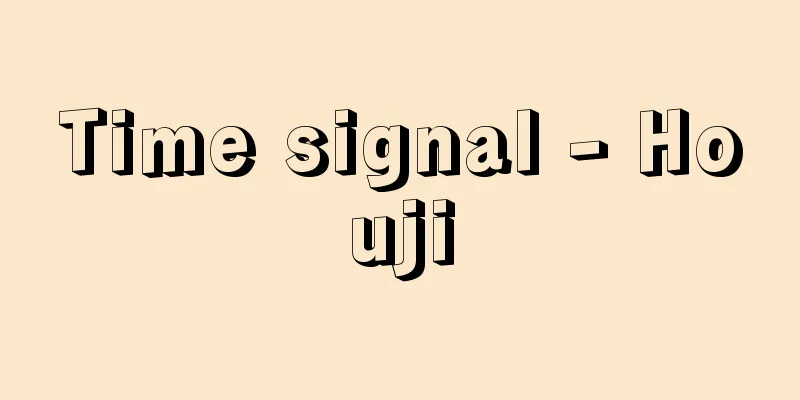Time signal - Houji

|
To inform the public of the time by means of sound, light, electricity, radio waves, etc. The earliest method was by the sound of bells or drums. The bells of Japanese temples were originally used for religious services, but they also served the function of announcing the time. The sound of bells on Western clock towers also widely announces the time. In Japan, since September 9, 1871 (Meiji 4), it has been decreed by Dajokan decree No. 453 that a single cannon shot be fired at noon in the inner citadel of the Imperial Palace in Tokyo. The Ministry of the Army was responsible for announcing the time with a midday cannon. Due to budgetary cuts at the Ministry of the Army, this was abolished on September 15, 1922 (Taisho 11), after which the City of Tokyo took over and fired a midday cannon, but from May 1, 1929 (Showa 4), this was replaced by a siren. Local cities also began announcing the time with a midday cannon from March 1879 with the permission of the Ministry of the Interior, and later switched to sirens, but with the spread of radio and television, the time was replaced by broadcasting stations. The position of a ship at sea is determined by celestial observations, but to do this, it is necessary to know the exact time. Before World War II, at least ocean-going ships were equipped with chronometers to obtain Greenwich Mean Time and keep accurate time. Greenwich Mean Time is now reported by radio, but before that, especially for ships, it was reported by a time ball. A time ball is a device that tells the time by observing the moment a ball is dropped at noon from a high hanging ball on a pier in a port. Time balls were installed in Yokohama and Kobe in 1903 (Meiji 36), and later in ports such as Moji in Fukuoka Prefecture, Nagasaki, and Osaka. With the invention of wireless telegraphy, time balls became obsolete, and they disappeared after World War II. Radio time signaling began in the United States in 1905, and in Japan it was carried out in 1911 through the Choshi Wireless Telegraph Station (Chiba Prefecture), and in 1916 through the Funabashi Wireless Telegraph Station (Chiba Prefecture). Academic time signaling began in 1932, and shortwave time signaling in 1938. Both of these send out time signals at regular times, but after World War II they began to send signals every second, and in 1948 (Showa 23), longwave time signaling began from the Kemigawa Wireless Transmitter Station in Kemigawa, Chiba Prefecture, and the following year, the Ministry of Posts and Telecommunications Radio Research Laboratory (now the National Institute of Information and Communications Technology) in Koganei City, Tokyo began to send out continuous minutes and seconds signals day and night with the call sign JJY at frequencies of 2.5, 5, 10, and 15 MHz. Subsequent improvements have been made to the system, which continues to this day. The shortwave time signaling was abolished at the end of March 2001 (Heisei 13), and currently only longwave time signals are sent out. The current time signal is in the form of a standard radio signal, which indicates universal time and ticks off ephemeris seconds. NHK receives the standard radio signal, corrects its own clock, and broadcasts the time signal. [Toshio Watanabe] [Reference items] | time|Source: Shogakukan Encyclopedia Nipponica About Encyclopedia Nipponica Information | Legend |
|
音、光、電気、電波などの手段により一般に時刻を知らせること。もっとも早い段階での方法は鐘や太鼓の音によるものであった。日本の寺院の鐘は元来勤行(ごんぎょう)のためのものであったが、時を知らせる機能を果たした。西洋の時計塔の鐘の音も時を広く知らせるものである。 日本では1871年(明治4)9月9日以来、東京の宮城内本丸において正午に大砲1発を放って報時とすることが太政(だじょう)官達453号で定められた。午砲による報時は陸軍省が担当した。陸軍省の予算緊縮で1922年(大正11)9月15日これが廃止され、その後は東京市が受け継いで午砲を発したが、1929年(昭和4)5月1日からはサイレンにかわった。各地方都市も1879年3月から内務省の許可を得て午砲による報時を行い、のちにサイレンにかえたが、ラジオやテレビの普及で放送局の報時にかわった。 航海中の船舶の位置は天体観測により決定するが、そのためには正確な時刻を知る必要がある。第二次世界大戦以前には少なくとも遠洋航海する船舶はクロノメーターを積載して、グリニジ平均時を得て、正確な時刻を保持した。グリニジ平均時の報時は現在は無線報時によるが、それ以前、とくに船舶に対しては報時球(時球)によって行われた。報時球とは、港湾の埠頭(ふとう)に高くつるした球を正午に落下させ、その瞬時を観測して時刻を知る装置である。1903年(明治36)に横浜、神戸に報時球が置かれ、その後、福岡県門司(もじ)、長崎、大阪などの各港でも行われた。無線電信の発明により報時球の利用価値がなくなり、第二次世界大戦以後姿を消した。無線報時は1905年アメリカで始められ、日本でも1911年から銚子(ちょうし)無線電信局(千葉県)を通じて、1916年には船橋無線電信局(千葉県)を通じて行われた。1932年からは学用報時が、1938年には短波報時が始まった。いずれも定時に報時信号を発するが、第二次世界大戦後は毎秒を送信するものになり、1948年(昭和23)に千葉県の検見川(けみがわ)にある検見川無線送信所から長波報時が、翌年には東京の小金井市にある郵政省電波研究所(現、情報通信研究機構)からJJYのコールサイン、2.5、5、10、15メガヘルツの周波数で昼夜連続分秒報時が始まり、その後の改良が加えられて今日に至っている。なお、短波報時は2001年(平成13)3月末で廃止され、現在は長波報時の電波のみが発射されている。 現在の報時は標準電波報時形式で、その報時信号は時刻としては世界時を示し、時間としては暦表時の秒を刻むものである。NHKは標準電波を受信し、自己の時計を補正して時報を放送している。 [渡辺敏夫] [参照項目] | |出典 小学館 日本大百科全書(ニッポニカ)日本大百科全書(ニッポニカ)について 情報 | 凡例 |
>>: 梆子 - housi (English spelling) bāng zı
Recommend
Potassium bromide
A compound of potassium and bromine. It is common...
Cost accounting - Genkakeisan (English)
In general, it is often used as a term to indicat...
long gallery
…In Italian Renaissance mansions, corridors were ...
Hokushin Ittō-ryū
A school of swordsmanship that emerged in the lat...
serekh
...The move of the capital from Thinis to Memphis...
Tetraogallus
…Among the partridges, the European partridge ( P...
Toughness
…Furthermore, there is a double cup type cut surf...
Kwinana
…Fremantle, located to the west of the city at th...
"Elegy of Adonis"
…Years of birth and death unknown. He composed pa...
Rhomborrhina unicolor (English name) Rhomborrhina unicolor
… [Chokane Hayashi]. … *Some of the terminology t...
Corydalis - Corydalis
A biennial plant of the Papaveraceae family (APG ...
Radiolarite
...Species such as the Japanese hominin Acanthome...
Heraclitus - Herakleitos
A Greek philosopher. Born into the royal family o...
Abū Muammad al-arīrī (English spelling)
A medieval Iraqi storyteller. Born in Masha'n...
Eads Bridge - Eads Bridge
Eads Bridge : A bridge over the Mississippi River ...




![Klyuchev [mountain] - Klyuchev](/upload/images/67cb70466111c.webp)



![Kobe [city] - Kobe](/upload/images/67cb8bfe110b8.webp)
